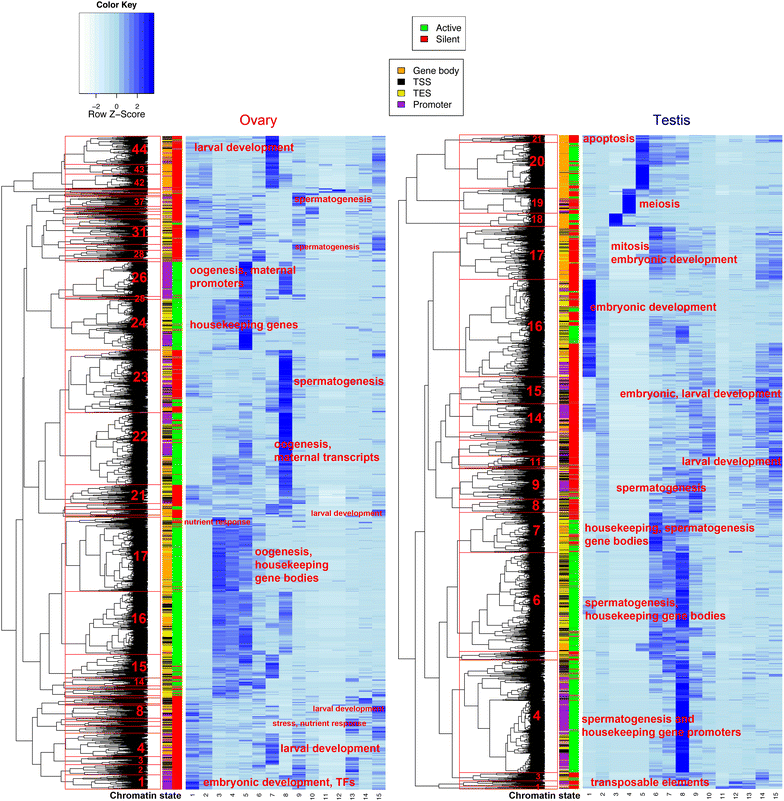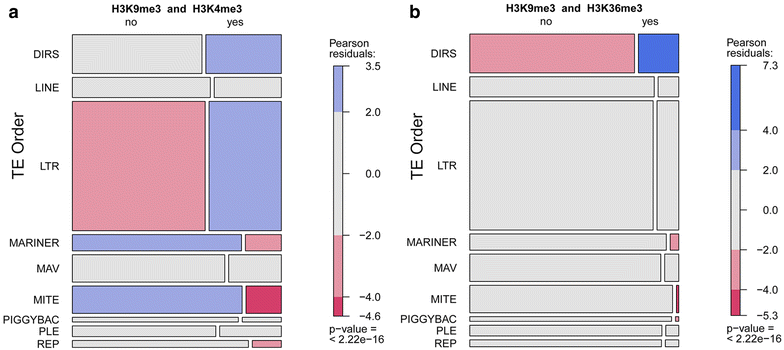Sex-specific chromatin landscapes in an ultra-compact chordate genome
- PMID: 28115992
- PMCID: PMC5240408
- DOI: 10.1186/s13072-016-0110-4
Sex-specific chromatin landscapes in an ultra-compact chordate genome
Abstract
Background: In multicellular organisms, epigenome dynamics are associated with transitions in the cell cycle, development, germline specification, gametogenesis and inheritance. Evolutionarily, regulatory space has increased in complex metazoans to accommodate these functions. In tunicates, the sister lineage to vertebrates, we examine epigenome adaptations to strong secondary genome compaction, sex chromosome evolution and cell cycle modes.
Results: Across the 70 MB Oikopleura dioica genome, we profiled 19 histone modifications, and RNA polymerase II, CTCF and p300 occupancies, to define chromatin states within two homogeneous tissues with distinct cell cycle modes: ovarian endocycling nurse nuclei and mitotically proliferating germ nuclei in testes. Nurse nuclei had active chromatin states similar to other metazoan epigenomes, with large domains of operon-associated transcription, a general lack of heterochromatin, and a possible role of Polycomb PRC2 in dosage compensation. Testis chromatin states reflected transcriptional activity linked to spermatogenesis and epigenetic marks that have been associated with establishment of transgenerational inheritance in other organisms. We also uncovered an unusual chromatin state specific to the Y-chromosome, which combined active and heterochromatic histone modifications on specific transposable elements classes, perhaps involved in regulating their activity.
Conclusions: Compacted regulatory space in this tunicate genome is accompanied by reduced heterochromatin and chromatin state domain widths. Enhancers, promoters and protein-coding genes have conserved epigenomic features, with adaptations to the organization of a proportion of genes in operon units. We further identified features specific to sex chromosomes, cell cycle modes, germline identity and dosage compensation, and unusual combinations of histone PTMs with opposing consensus functions.
Keywords: Dosage compensation; Endocycle; Enhancer; Heterochromatin; Histone; Polycomb; Spermatogenesis; Transposable elements.
Figures






Similar articles
-
Conserved patterns of nuclear compartmentalization are not observed in the chordate Oikopleura.Biol Cell. 2007 May;99(5):273-87. doi: 10.1042/BC20060124. Biol Cell. 2007. PMID: 17288541
-
Plasticity of histone modifications across the invertebrate to vertebrate transition: histone H3 lysine 4 trimethylation in heterochromatin.Chromosome Res. 2005;13(1):57-72. doi: 10.1007/s10577-005-6845-6. Chromosome Res. 2005. PMID: 15791412
-
ChromaSig: a probabilistic approach to finding common chromatin signatures in the human genome.PLoS Comput Biol. 2008 Oct;4(10):e1000201. doi: 10.1371/journal.pcbi.1000201. Epub 2008 Oct 17. PLoS Comput Biol. 2008. PMID: 18927605 Free PMC article.
-
Broad Chromatin Domains: An Important Facet of Genome Regulation.Bioessays. 2017 Dec;39(12). doi: 10.1002/bies.201700124. Epub 2017 Oct 23. Bioessays. 2017. PMID: 29058338 Review.
-
Histone lysine methylation and chromatin replication.Biochim Biophys Acta. 2014 Dec;1839(12):1433-9. doi: 10.1016/j.bbagrm.2014.03.009. Epub 2014 Mar 28. Biochim Biophys Acta. 2014. PMID: 24686120 Review.
Cited by
-
Epigenetic machinery is functionally conserved in cephalopods.BMC Biol. 2022 Sep 14;20(1):202. doi: 10.1186/s12915-022-01404-1. BMC Biol. 2022. PMID: 36104784 Free PMC article.
-
A brief review of vertebrate sex evolution with a pledge for integrative research: towards 'sexomics'.Philos Trans R Soc Lond B Biol Sci. 2021 Aug 30;376(1832):20200426. doi: 10.1098/rstb.2020.0426. Epub 2021 Jul 12. Philos Trans R Soc Lond B Biol Sci. 2021. PMID: 34247497 Free PMC article. Review.
-
Distinct core promoter codes drive transcription initiation at key developmental transitions in a marine chordate.BMC Genomics. 2018 Feb 26;19(1):164. doi: 10.1186/s12864-018-4504-5. BMC Genomics. 2018. PMID: 29482522 Free PMC article.
-
ChIP-ping the branches of the tree: functional genomics and the evolution of eukaryotic gene regulation.Brief Funct Genomics. 2018 Mar 1;17(2):116-137. doi: 10.1093/bfgp/ely004. Brief Funct Genomics. 2018. PMID: 29529131 Free PMC article. Review.
-
Encyclopaedia of eukaryotic DNA methylation: from patterns to mechanisms and functions.Biochem Soc Trans. 2022 Jun 30;50(3):1179-1190. doi: 10.1042/BST20210725. Biochem Soc Trans. 2022. PMID: 35521905 Free PMC article.
References
Publication types
MeSH terms
Substances
LinkOut - more resources
Full Text Sources
Other Literature Sources
Molecular Biology Databases
Miscellaneous

